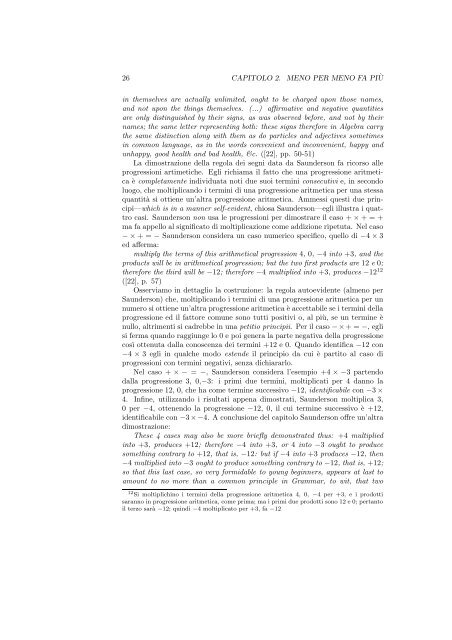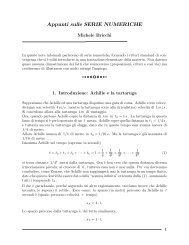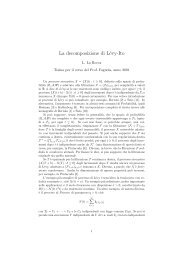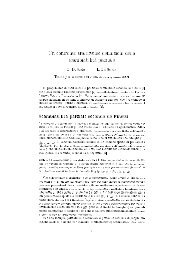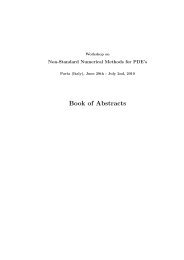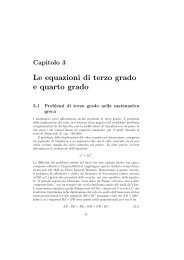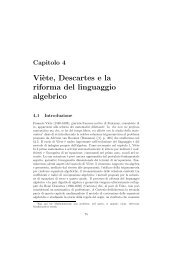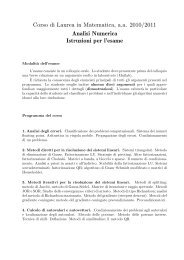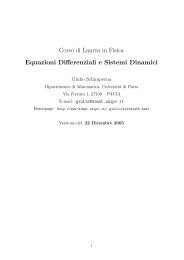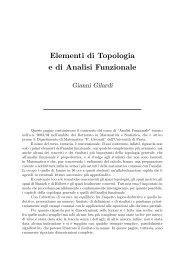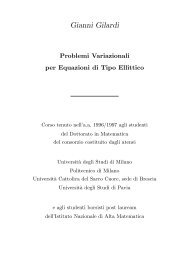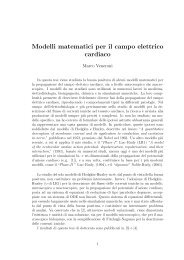Capitolo II - Dipartimento di Matematica
Capitolo II - Dipartimento di Matematica
Capitolo II - Dipartimento di Matematica
You also want an ePaper? Increase the reach of your titles
YUMPU automatically turns print PDFs into web optimized ePapers that Google loves.
26 CAPITOLO 2. MENO PER MENO FA PIÙ<br />
in themselves are actually unlimited, ought to be charged upon those names,<br />
and not upon the things themselves. (...) affirmative and negative quantities<br />
are only <strong>di</strong>stinguished by their signs, as was observed before, and not by their<br />
names; the same letter representing both: these signs therefore in Algebra carry<br />
the same <strong>di</strong>stinction along with them as do particles and adjectives sometimes<br />
in common language, as in the words convenient and inconvenient, happy and<br />
unhappy, good health and bad health, &c. ([22], pp. 50-51)<br />
La <strong>di</strong>mostrazione della regola dei segni data da Saunderson fa ricorso alle<br />
progressioni artimetiche. Egli richiama il fatto che una progressione aritmetica<br />
è completamente in<strong>di</strong>viduata noti due suoi termini consecutivi e, in secondo<br />
luogo, che moltiplicando i termini <strong>di</strong> una progressione aritmetica per una stessa<br />
quantità si ottiene un’altra progressione aritmetica. Ammessi questi due principî—which<br />
is in a manner self-evident, chiosa Saunderson—egli illustra i quattro<br />
casi. Saunderson non usa le progressioni per <strong>di</strong>mostrare il caso +×+ = +<br />
ma fa appello al significato <strong>di</strong> moltiplicazione come ad<strong>di</strong>zione ripetuta. Nel caso<br />
−×+ = − Saunderson considera un caso numerico specifico, quello <strong>di</strong> −4×3<br />
ed afferma:<br />
multiply the terms of this arithmetical progression 4, 0, −4 into +3, and the<br />
products will be in arithmetical progression; but the two first products are 12 e 0;<br />
therefore the third will be −12; therefore −4 multiplied into +3, produces −12 12<br />
([22], p. 57)<br />
Osserviamo in dettaglio la costruzione: la regola autoevidente (almeno per<br />
Saunderson) che, moltiplicando i termini <strong>di</strong> una progressione aritmetica per un<br />
numero si ottiene un’altra progressionearitmetica è accettabile se i termini della<br />
progressione ed il fattore comune sono tutti positivi o, al più, se un termine è<br />
nullo, altrimenti si cadrebbe in una petitio principii. Per il caso −×+ = −, egli<br />
si ferma quando raggiunge lo 0 e poi genera la parte negativa della progressione<br />
così ottenuta dalla conoscenza dei termini +12 e 0. Quando identifica −12 con<br />
−4 × 3 egli in qualche modo estende il principio da cui è partito al caso <strong>di</strong><br />
progressioni con termini negativi, senza <strong>di</strong>chiararlo.<br />
Nel caso + × − = −, Saunderson considera l’esempio +4 × −3 partendo<br />
dalla progressione 3, 0,−3: i primi due termini, moltiplicati per 4 danno la<br />
progressione 12, 0, che ha come termine successivo −12, identificabile con −3×<br />
4. Infine, utilizzando i risultati appena <strong>di</strong>mostrati, Saunderson moltiplica 3,<br />
0 per −4, ottenendo la progressione −12, 0, il cui termine successivo è +12,<br />
identificabile con −3×−4. A conclusione del capitolo Saunderson offre un’altra<br />
<strong>di</strong>mostrazione:<br />
These 4 cases may also be more briefly demonstrated thus: +4 multiplied<br />
into +3, produces +12; therefore −4 into +3, or 4 into −3 ought to produce<br />
something contrary to +12, that is, −12: but if −4 into +3 produces −12, then<br />
−4 multiplied into −3 ought to produce something contrary to −12, that is, +12;<br />
so that this last case, so very formidable to young beginners, appears at last to<br />
amount to no more than a common principle in Grammar, to wit, that two<br />
12 Si moltiplichino i termini della progressione aritmetica 4, 0, −4 per +3, e i prodotti<br />
saranno in progressione aritmetica, come prima; ma i primi due prodotti sono 12 e 0; pertanto<br />
il terzo sarà −12; quin<strong>di</strong> −4 moltiplicato per +3, fa −12


